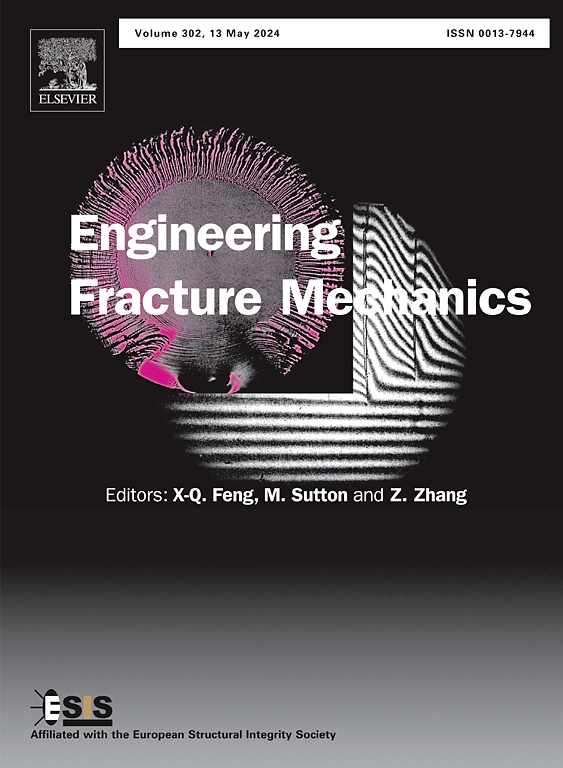Fracture behavior of intermetallic clusters in HVDC AlSiMgMn alloys: a finite element study based on actual morphologies
IF 4.7
2区 工程技术
Q1 MECHANICS
引用次数: 0
Abstract
AlSiMgMn alloy die castings are frequently applied due to their excellent surface quality producing efficiency and low producing costs. The brittle Fe-rich intermetallics serve as potential fracture initiation sites during tensile. Their morphology and uneven distribution significantly influence the mechanical properties of die-cast aluminum alloys. Three-dimensional (3D) characteristics of Fe-rich intermetallic and clusters of high vacuum die-cast (HVDC) AlSi10MgMn alloys were obtained by X-ray computed microtomography (μ-CT), and the alloy dynamic fracture was investigated using in-situ microtomography tensile. In this study, the finite element analysis based on the actual intermetallics characteristics was further performed to study the effect of the characteristic including clustering on stress and strain as well as fracture. The results show that individual polyhedral and hexahedral Fe-rich intermetallics tend to debond at high strains, while octagonal dendrite shape intermetallics fracture at low strains. When the volume of intermetallics within the cluster exceeded 20000 μm3, the aggregated intermetallics improved the load-bearing capacity and the force transfer, increasing the yield strength of alloys. However, this would accelerate the intermetallic damage process and result in the hexahedron and polyhedron shape intermetallics to fracture. Moreover, the areas with high-stress triaxiality of the matrix increased, reducing the plastic deformation. After cracks formed from fractured intermetallics, the matrix in the areas with high-stress triaxiality between the cracks occurred quasi-cleavage fracture, accelerating the crack propagation and decreasing the elongation of the alloy.
高压直流AlSiMgMn合金中金属间簇的断裂行为:基于实际形貌的有限元研究
AlSiMgMn合金压铸件以其优异的表面质量、生产效率和低廉的生产成本而被广泛应用。脆性富铁金属间化合物是拉伸过程中潜在的断裂起始点。它们的形态和分布不均对压铸铝合金的力学性能有显著影响。利用x射线计算机显微断层扫描(μ-CT)获得了高真空压铸(HVDC) AlSi10MgMn合金富铁金属间化合物和团簇的三维(3D)特征,并利用原位显微断层扫描拉伸技术研究了合金的动态断口。本研究进一步基于实际金属间化合物特性进行有限元分析,研究聚类等特性对应力应变及断裂的影响。结果表明,在高应变下,单个多面体和六面体富铁金属间化合物倾向于脱落,而在低应变下,八角形枝晶型金属间化合物倾向于断裂。当团簇内金属间化合物的体积超过20000 μm3时,聚集的金属间化合物改善了合金的承载能力和力传递,提高了合金的屈服强度。然而,这会加速金属间化合物的损伤过程,导致六面体和多面体形状的金属间化合物断裂。同时,基体高应力三轴性区域增加,塑性变形减小。金属间化合物断裂形成裂纹后,裂纹间高应力三轴区域的基体发生准解理断裂,加速裂纹扩展,降低合金的伸长率。
本文章由计算机程序翻译,如有差异,请以英文原文为准。
求助全文
约1分钟内获得全文
求助全文
来源期刊
CiteScore
8.70
自引率
13.00%
发文量
606
审稿时长
74 days
期刊介绍:
EFM covers a broad range of topics in fracture mechanics to be of interest and use to both researchers and practitioners. Contributions are welcome which address the fracture behavior of conventional engineering material systems as well as newly emerging material systems. Contributions on developments in the areas of mechanics and materials science strongly related to fracture mechanics are also welcome. Papers on fatigue are welcome if they treat the fatigue process using the methods of fracture mechanics.

 求助内容:
求助内容: 应助结果提醒方式:
应助结果提醒方式:


